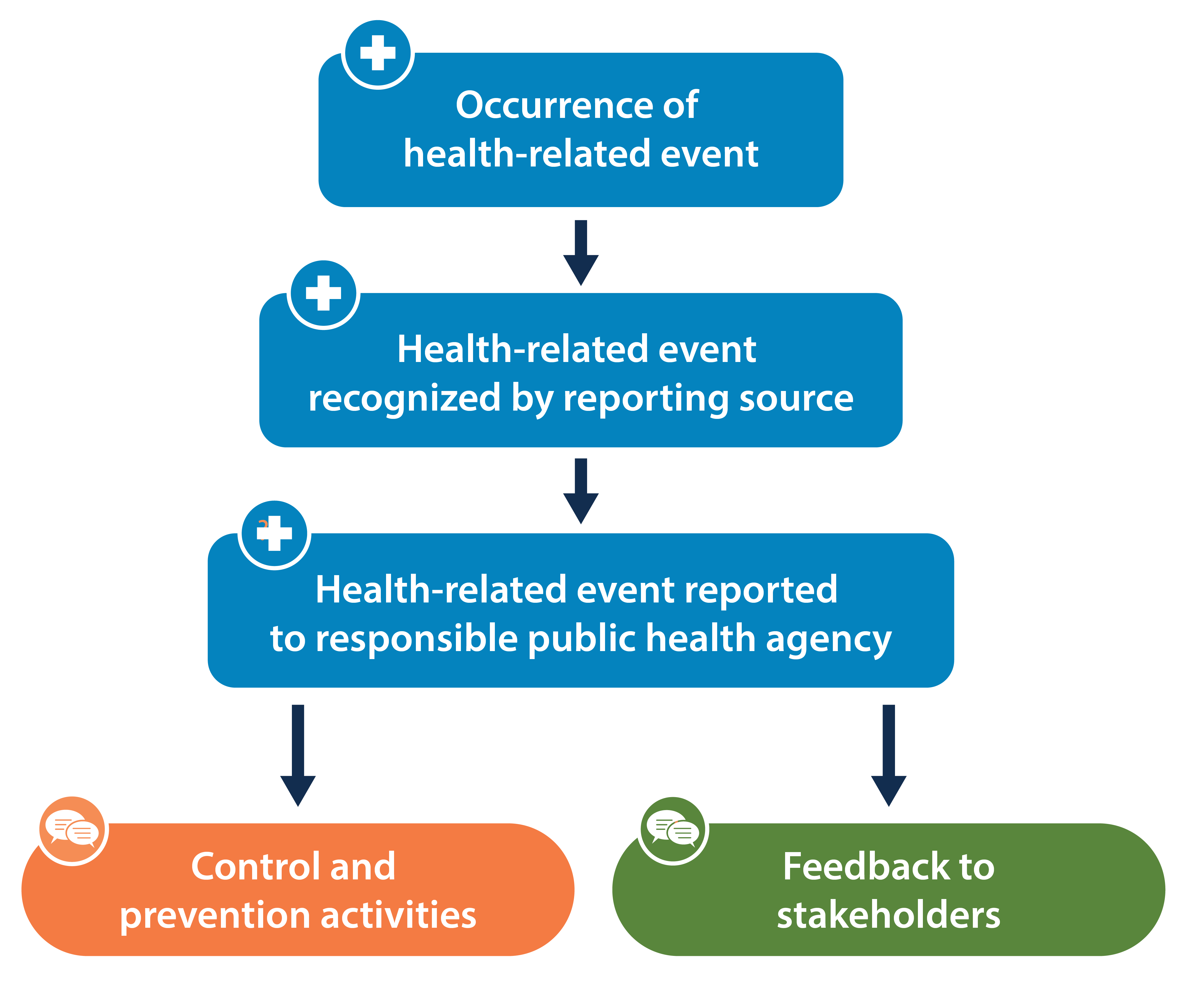3. Health Data Sources
Surveillance
Public health surveillance is the "ongoing systematic collection, analysis, and interpretation of data, closely integrated with the timely dissemination of these data to those responsible for preventing and controlling disease and injury."1 Surveillance activities are usually associated with the study of infectious diseases.
The CDC, WHO, and many other institutions operate databases and automated electronic reporting systems to track and monitor outbreaks of specific diseases, like HIV. The National Notifiable Diseases Surveillance System (NNDSS), a part of the CDC, is an example of such a program. These systems function through the efforts of local and state health departments, working in tandem with a variety of health care providers (laboratories, hospitals, private providers), who are mandated by law to report cases of certain diseases. This allows local, state, and federal health agencies to detect individual cases, control outbreaks, and implement prevention and intervention strategies.2 Data from 57 state, territorial, and local reporting jurisdictions are published weekly and annually in the Morbidity and Mortality Weekly Report (MMWR). Additionally, the National Center for Emerging Zoonotic Infectious Diseases (NCEZID) tracks emerging zoonotic infectious diseases like the SARS-CoV-2 virus that results in COVID-19.
COVID-19 Surveillance
During the COVID-19 pandemic, surveillance played a prominent role in government’s efforts. During this time, local, state, and federal governments used disease surveillance to help make decisions for public safety as well as to monitor community cases to understand the spread of the disease. The CDC has created several different COVID-19 related surveillance systems.3 These include:
- COVID Data Tracker: A daily update of the number of cases, deaths, hospitalizations, and vaccinations at the national, state, and county level. This information includes both new events and the total.
- COVID Wastewater Surveillance: Monitors the presence of the virus in the wastewater in counties.
- Seroprevalence of COVID-19: Monitors how much of the population has been infected with the virus.
- COVID-19 Variants & Genomic Surveillance: The data included show the proportion of the virus variants globally, nationally, and regionally as well as the genomic sequences that are available.
Disease Registries
Disease registries are another type of public health surveillance. Registries are systems that allow people to collect, store, retrieve, analyze, and disseminate information about people with a specific disease or condition. Disease registries let researchers estimate how large a health problem is, determine the incidence of the disease, study trends over time, and evaluate the effects of certain environmental exposures. Registries provide information to improve the quality and safety of care and allow for comparison of effective treatment.
Registries are kept by governments, hospitals, universities, non-profits, and private groups. They store data from hospital records, lab reports, and other sources. Because clinical data is sent securely to registries from the various points of care that a patient may receive, registries allow the possibility to track and better understand rare diseases.4
In the United States, there are several examples of disease registries including:
- United States Renal Data System: Collects information on chronic kidney disease and end-stage renal disease.
- Cystic Fibrosis Foundation Patient Registry: Collects health information on patients with cystic fibrosis who receive care in a Cystic Fibrosis Foundation accredited facility.
- National Amyotrophic Lateral Sclerosis (ALS) Registry: Collects information on ALS (Lou Gehrig’s Disease) patients.
In addition, the National Institutes of Health maintains a comprehensive list of registries.
Surveillance data has a higher validity than surveys because the data comes from lab tests, diagnoses, and other patient records. Registries also make this data easy to store and analyze. The downside to surveillance data is that it can be difficult to accurately track trends because diseases sometimes change definitions. Data can also be lacking if hospitals or doctors do not report it.
This diagram shows the steps in a surveillance system, which results in surveillance data.5
Figure 2. Simplified example of steps in a surveillance system
1. Nsubuga P, White ME, Thacker SB, et al. Public Health Surveillance: A Tool for Targeting and Monitoring Interventions. In: Jamison DT, Breman JG, Measham AR, et al., editors. Disease Control Priorities in Developing Countries. 2nd edition. Washington (DC): World Bank; 2006. Chapter 53.
2. "National Notifiable Diseases Surveillance System (NNDSS)" Centers for Disease Control and Prevention (CDC), 8/19/2015. Web 1/24/2017.
3. "COVID Data Tracker." Centers for Disease Control and Prevention. Atlanta, GA: US Department of Health and Human Services, CDC; 2022, August 14. https://covid.cdc.gov/covid-data-tracker
4. American Medical Association (2014) What is a Clinical Data Registry? National Quality Registry Network, 2016.
5. Centers for Disease Control and Prevention. Updated guidelines for evaluating public health surveillance systems: recommendations from the guidelines working group. MMWR 2001;50(No. RR-13): 22. https://www.cdc.gov/mmwr/pdf/rr/rr5013.pdf
